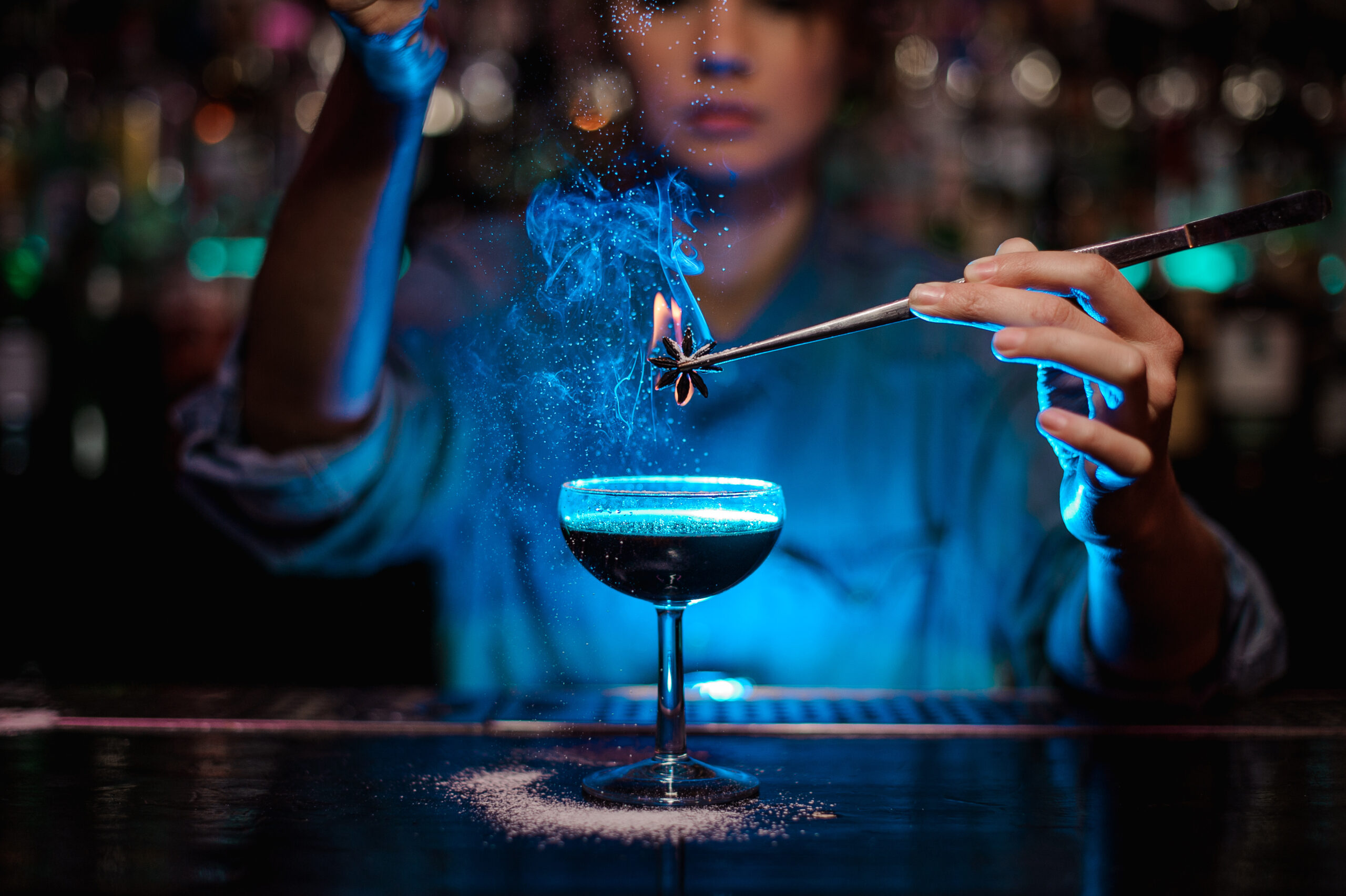The new body horror film “The Substance” from French filmmaker Coralie Fargeat is not for the squeamish. A satire about the tolls of toxic beauty culture, the film is set in a fairytale-like Hollywood. Demi Moore, in a career-best performance, stars as Elisabeth Sparkle, a former A-lister who lives in a fancy apartment in the Hollywood Hills overlooking the city. On her 50th birthday, she is unceremoniously fired by a callous studio head named Harvey (Dennis Quaid, marvelously disgusting) from her long-time hosting gig of a daytime fitness show. Driving home, she sees her billboard being taken down. The image of her body literally being thrown away as garbage causes her to spiral and get into a minor car accident. At the hospital, she’s told about a mysterious new drug called The Substance, which promises a new, better you. Drowning in her own self-hatred and desperate for her job back, Elisabeth injects herself with the miracle drug and is reborn–quite literally–as a perky young woman named Sue (Margaret Qualley), who is quickly hired as the show’s new host. The two must share their body for one week at a time, but as Sue gets a taste for fame–and the same damaging self-hatred creeps in, the balance is soon lost, plunging both into a grotesque waking nightmare, culminating in what may well be the best depiction ever committed to celluloid of the stark contrast between the prestige of having your star on the Walk of Fame and what Hollywood Blvd is actually like.
“The Substance” premiered in competition at the 77th annual Cannes Film Festival, where Fargeat won the award for Best Screenplay. I saw the film at the Karlovy Vary International Film Festival back in June, and it was so viscerally upsetting that by the final act, most of the audience was in a full-body cringe; one woman a few seats down in my row was literally shaking and crying. While the film’s graphic nature has proven divisive, I haven’t had a better time at the movies all year.
For me, the film has the perfect balance of mordant humor, deranged imagery, and brutal societal satire. You can feel Fargeat working through her issues with self-hatred via the art of cinema. She makes you feel the violence that is all around us and how it can affect your sense of self. The film made me think a lot about my own relationship with my body as I age. It made me want to be kinder to my younger self, my future self, and most importantly, my current self. It also left me with a lot of questions for Coralie Fargeat, the woman who created this repulsive fever dream.
Fargeat grew up in Paris, where she spent her childhood trying to escape reality, often recording stories she made up on a tape recorder. She got the filmmaking bug as a teenager when a magazine ran a contest for amateur filmmakers to make their own short versions of “Star Wars.” Although her film, shot with a camcorder, didn’t win, she fell in love with the medium of film. After studying for three years at Sciences Po Paris, she interned on an American short film being shot on campus. She then studied at the French film school Le Fémis. Her first short film, a period piece called “The Telegram,” won 13 awards at multiple film festivals.
She began working in genre filmmaking with her follow-up short “Reality+,” a sci-fi film about a new technology that allows users to see themselves and each other in their dream bodies for 12-hour intervals. Her debut feature film “Revenge,” a bloody tale of rape and murder, premiered at the 42nd Toronto International Film Festival as part of the Midnight Madness section. Fargeat is one of the founding signatories of Collectif 50/50, which aims towards gender equality at film festivals and across the film industry.
For this month’s Female Filmmakers in Focus column, RogerEbert.com spoke to Fargeat over Zoom about the music that inspired the film’s fleshy feelings, Hollywood as a symbol for our collective dreams, filmmaking as therapy, how monstrous myths shape how we understand our bodies, and the importance of new female voices in film.

You’ve said that the idea for “The Substance” began with certain images and sounds in your head. I’d love to know what particular sounds you had in mind.
In my films, sound and image are truly important ways to express my ideas and the final world that I’m going to craft. So at the same time that I’m working on the theme and the story, I research images and sounds that are going to be the emotional core of the film and give it its unique personality. They are going to be the way to express the specificity of the feeling that I want to say. I listen to a lot of music. It’s usually music that can put me in some sort of trance regarding the universe of the film. In this case, it was a lot of experimental music. Music that expresses the flesh. I listened to Micah Levi’s score from “Under the Skin,” which has this organic, experimental vibe that is linked to the inner world, that is linked to sensation, that is linked to what’s inside your body.
There was a lot of music also from other composers that had this kind of heartbeat or pulsation. It was a lot of pulsative music, which I think, unconsciously, is related to the heartbeat of the new human being or the way you can feel with your body. I also listened to hyper-sexualized music, which built the universe of the show Pump It Up. This is really how I build the scenes and the most important aspect of how I will drive them. So music very strongly influenced me from the start and helped me put my ideas on the screen in a way that I know will reach the audience, which is also the best way to express myself.
The film has a visceral presentation of Hollywood Boulevard as being the height of glamor but also full of garbage. I used to live just off Hollywood Boulevard. It’s disgusting there most of the time, and I thought that opening sequence really distilled the highs and the lows of it well. Can you talk about how that sequence came to be?
I had been to Los Angeles, and it’s even where I started to write the movie. So, I have a fascination with what Hollywood Boulevard represents. I work with symbolism. I don’t use a lot of dialogue. The way I craft my stories is by using symbolism. I started to write the best symbolism I could think of about how beauty has been made into some kind of goal or prison with its promise of beauty and happiness, and when you lose that, you crumble. For me, that was Hollywood. It’s still this dreamy representation that is also linked to appearance and how people see you. There is this hyper-scrutinization and also a surface of happiness and joy. So, it was a symbol I was interested in exploring because I think it embodies everything every woman I think has to deal with. About how, depending on what you look like or don’t look like, you will be valued or not valued or feel accepted or not accepted.
On Hollywood Boulevard, there is this symbolic star, and it is such a powerful symbol of all of that. When the star fits those expectations, it’s loved, it’s worshiped, it’s bright, and everyone looks at it. When it starts to crack, to be dirty, to age, basically, or not fit the beauty standard, then people don’t care anymore, and they treat it like a piece of trash. I love the idea of playing with this very simple idea, but it’s so powerful at the same time that just this image can represent the violence of how you can be seen and valued or not valued, depending on what you represent or what the world decides that you represent or not.
So that’s also why I wanted the world of the film to have this non-realistic touch and vibe. So it would be clear that Hollywood is a symbol here. It’s like the Hollywood of our unconscious collective mind. The one that we grew up with. Everyone has an idea of how it is, even those who’ve never been because we’ve seen it in movies. It’s a huge cultural and social symbol that embodies many of the themes I’m dealing with in the film.

Did you find the process of writing the script and then completing the film therapeutic?
Oh yes, I would say a hundred percent yes on many levels. Making this film was such a strong way to express myself, everything I felt inside, and the violence of everything I felt around me. To be able to make something with those feelings and express it in my own creative language with filmmaking was so strong and so liberating. It was also a way to step into the world and not feel limited by the thoughts that have been putting me down, like “you’re going to age” or “you’re going to be erased.” Making something with those feelings was very empowering and liberating.
But I’m not gonna lie. I think that all those things that you carry with yourself since you’re a kid, about how people perceive you, how you feel like you don’t fit, that you are never good enough, all the beauty standards, I think that they somehow stay forever on your shoulder. You can tame them. You can make them less loud. You can put them to sleep for some time, but they are still, I think, your strongest inner enemy that you have to deal with, and that’s what I wanted to show. I wanted to show the reality of how society still works and what we have to live with. To show how violent it is, but also to show how difficult it is to make that change on our own. If society and everything else around it doesn’t change, you have to be a superhero not to feel impacted by all of this.
The last thing I want with this movie is for it to become a new injunction for women to feel good about themselves. I really believe that it’s an ongoing journey. To me, it’s more like I wish we would allow women to feel at ease; also, if you don’t feel good, it’s not your fault; everything around you is responsible for making you feel like that. So, hopefully, if we see some change in society, it will help us all get out of this jail that we have built for ourselves.
Did you study the mythology of monstrous women as you crafted the darker second half of the film?
I researched a lot of monstrous figures, not necessarily women, but more like what was considered freaks. “The Elephant Man” was a very strong representation of a monstrous figure, especially because the film was based on someone who existed. I studied other representations of the monster in many different films like Quasimodo. I also fed myself with research into plastic artists, who do sculptures and craft their own monsters by mixing human flesh, animal parts, and all of this together. So, I fed my inspiration with many representations of what is considered a freak. I also studied the Disney of our childhood. There are witch figures, but also the dancing elephants in their ballet shoes. I was interested in all these representations of what is monstrous, of what is considered ridiculous, or the opposite of the beautiful princess, which represents the ideal. I think we all grew up with that. I grew up with the myth of the beautiful, blonde, thin princess that would be saved by the prince, and everything else is rubbish. I think those myths and cultural images shape how we feel about ourselves and how we feel we fit or not fit. They are definitely strong cultural weapons that shape us one way or another.

You’ve spoken a lot about the need for parity at film festivals for women directors, so I was wondering if there were any other women whose films you admire or that you think readers should seek out.
Oh yes, there are many, and I’m so happy to discover more and more of them. Unfortunately, at this year’s Cannes Film Festival, I had my film, so I didn’t have time to go to other films. But there were so many new female directors that I was so interested in seeing their films. Lately, one of the female directors that I adored when I discovered her world was Jennifer Kent, who did “The Babadook.” Her film “The Nightingale” had such a strong impact on me in the way that it powerfully dealt with topics of inequality and social violence and did so in a very harsh way. It was something that knocked me out.
I love that all of these different filmmakers express themselves in their own way. For example, Céline Sciamma deals with these topics in her own way.
I love that more and more female filmmakers are succeeding in making their films and are allowed to express new imaginations, new creative worlds, and new ways of crafting a world of their own through cinema. When I grew up, it seemed like all the movies were made by male directors. But that is what built who I am, and I think it’s great that now there are new models and new imaginations, and there will be more and more.
I’m not gonna lie; parity is still not there at all. Things are starting to change, but there is still so much progress to be made. But something like Greta Gerwig’s “Barbie” was such a great film, and I think that’s what’s going to change the world; new eyes, new visions, new minds are going to be put out there and will be watched by the younger generation, who are going to feed themselves and build themselves on them.




